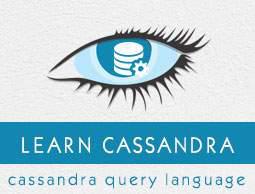Cassandra - Alter Table
Altering a Table
You can alter a table using the command ALTER TABLE. Given below is the syntax for creating a table.
Syntax
ALTER (TABLE | COLUMNFAMILY) <tablename> <instruction>
Using ALTER command, you can perform the following operations −
Add a column
Drop a column
Adding a Column
Using ALTER command, you can add a column to a table. While adding columns, you have to take care that the column name is not conflicting with the existing column names and that the table is not defined with compact storage option. Given below is the syntax to add a column to a table.
ALTER TABLE table name
ADD new column datatype;
Example
Given below is an example to add a column to an existing table. Here we are adding a column called emp_email of text datatype to the table named emp.
cqlsh:howcodex> ALTER TABLE emp
... ADD emp_email text;
Verification
Use the SELECT statement to verify whether the column is added or not. Here you
can observe the newly added column emp_email.
cqlsh:howcodex> select * from emp;
emp_id | emp_city | emp_email | emp_name | emp_phone | emp_sal
--------+----------+-----------+----------+-----------+---------
Dropping a Column
Using ALTER command, you can delete a column from a table. Before dropping a column from a table, check that the table is not defined with compact storage option. Given below is the syntax to delete a column from a table using ALTER command.
ALTER table name
DROP column name;
Example
Given below is an example to drop a column from a table. Here we are deleting
the column named emp_email.
cqlsh:howcodex> ALTER TABLE emp DROP emp_email;
Verification
Verify whether the column is deleted using the select statement, as shown below.
cqlsh:howcodex> select * from emp;
emp_id | emp_city | emp_name | emp_phone | emp_sal
--------+----------+----------+-----------+---------
(0 rows)
Since emp_email column has been deleted, you cannot find it anymore.
Altering a Table using Java API
You can create a table using the execute() method of Session class. Follow the steps given below to alter a table using Java API.
Step1: Create a Cluster Object
First of all, create an instance of Cluster.builder class of com.datastax.driver.core package as shown below.
//Creating Cluster.Builder object
Cluster.Builder builder1 = Cluster.builder();
Add a contact point (IP address of the node) using the addContactPoint() method of Cluster.Builder object. This method returns Cluster.Builder.
//Adding contact point to the Cluster.Builder object
Cluster.Builder builder2 = build.addContactPoint( "127.0.0.1" );
Using the new builder object, create a cluster object. To do so, you have a method called build() in the Cluster.Builder class. The following code shows how to create a cluster object.
//Building a cluster
Cluster cluster = builder.build();
You can build a cluster object using a single line of code as shown below.
Cluster cluster = Cluster.builder().addContactPoint("127.0.0.1").build();
Step 2: Create a Session Object
Create an instance of Session object using the connect() method of Cluster class
as shown below.
Session session = cluster.connect( );
This method creates a new session and initializes it. If you already have a keyspace, you can set it to the existing one by passing the KeySpace name in string format to this method as shown below.
Session session = cluster.connect(“ Your keyspace name ” );
Session session = cluster.connect(“ tp” );
Here we are using the KeySpace named tp. Therefore, create the session object
as shown below.
Step 3: Execute Query
You can execute CQL queries using the execute() method of Session class. Pass the query either in string format or as a Statement class object to the execute() method. Whatever you pass to this method in string format will be executed on the cqlsh.
In the following example, we are adding a column to a table named emp. To do so, you have to store the query in a string variable and pass it to the execute() method as shown below.
//Query
String query1 = "ALTER TABLE emp ADD emp_email text";
session.execute(query);
Given below is the complete program to add a column to an existing table.
import com.datastax.driver.core.Cluster;
import com.datastax.driver.core.Session;
public class Add_column {
public static void main(String args[]){
//Query
String query = "ALTER TABLE emp ADD emp_email text";
//Creating Cluster object
Cluster cluster = Cluster.builder().addContactPoint("127.0.0.1").build();
//Creating Session object
Session session = cluster.connect("tp");
//Executing the query
session.execute(query);
System.out.println("Column added");
}
}
Save the above program with the class name followed by .java, browse to the location where it is saved. Compile and execute the program as shown below.
$javac Add_Column.java
$java Add_Column
Under normal conditions, it should produce the following output −
Column added
Deleting a Column
Given below is the complete program to delete a column from an existing table.
import com.datastax.driver.core.Cluster;
import com.datastax.driver.core.Session;
public class Delete_Column {
public static void main(String args[]){
//Query
String query = "ALTER TABLE emp DROP emp_email;";
//Creating Cluster object
Cluster cluster = Cluster.builder().addContactPoint("127.0.0.1").build();
//Creating Session object
Session session = cluster.connect("tp");
//executing the query
session.execute(query);
System.out.println("Column deleted");
}
}
Save the above program with the class name followed by .java, browse to the location where it is saved. Compile and execute the program as shown below.
$javac Delete_Column.java
$java Delete_Column
Under normal conditions, it should produce the following output −
Column deleted


